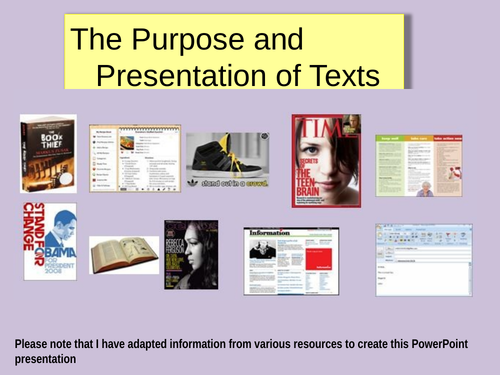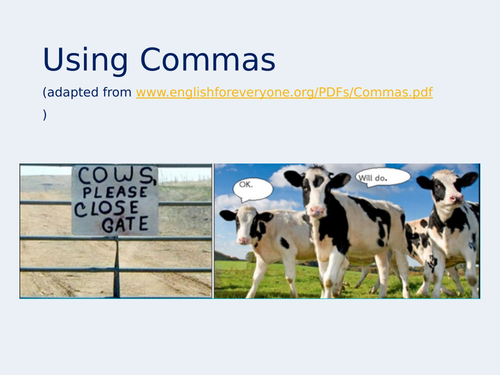9Uploads
3k+Views
1k+Downloads
English language arts

'Texts: Their Presentation and Purpose' & 'Language, Tone & Register' PPs
**‘Texts: Their Presentation and Purpose’ **
This Power Point demonstrates the relationship between types of texts, their formats/layouts and the purpose they serve (to inform, describe, persuade etc.)
**
‘Language, Tone & Register’**
Anna Michelle Chapman.

'Apostrophes: Part 1' & 'Apostrophes: Part 2' (Power Point Presentations)
’Apostrophes: Part 1’
This power point starts by explaining the two different uses for an apostrophe and moves on to focus on omissive apostrophes (apostrophes to signify missing letters in words/contractions, such as ‘don’t’ etc.)
Slides 5-21 act as a manual ‘stop-motion’ video to visually demonstrate how omissive apostrophes are used (click to change slides at an accelerated pace to achieve this effect.)
’Apostrophes: Part 2’ for possessive apostrophes.
I designed these resources for use with FE students ( Levels 1 and 2), but it could also be used with secondary school-aged learners, strong Entry 3 students, and some older primary-aged children.
The presentations also reference other aspects of English, including using formal/informal language and pronouns.
PS
My apologies to anyone who downloaded the previous version of this resource, which included a rather embarrassing error (for some reason, I wrote ‘comma’ instead of ‘apostrophe’ in one section.) Also, I accidentally submitted a version that could not be edited.

Narrative Genre (Information Table)
An understanding of narrative genre and generic codes can provide a framework (or a kind of ‘road map’) to analysing literature, films and TV shows and creating your own text.
My related presentation introduces these concepts and invites students to identify their preferred genres and recognise parallels between texts with generic similarities.
In addition to extending students’ vocabulary around literature and media, my introduction to genre and its conventions helps to consolidate concepts that learners already have some familiarity with. I hope that my resources on narrative genre will help to provide a cultural frame of reference- especially when negotiating and decoding new/unfamiliar narratives.
NB When using the ‘Narrative Genre’ table with students who are fairly new to this concept, I recommend splitting this information pack into smaller sections (or ‘chunks’), and using them with a limited number of texts that match the genres selected.
Also, this pack can be used as a revision guide or as a reference guide when discussing/analysing texts.
This resource and others can also be downloaded from my website: [www.annaliteracystuff.com .
Anna Michelle Chapman.

Narrative Genre Power Point
An understanding of narrative genre and generic codes can provide a framework (or a kind of ‘road map’) to analysing literature and creating your own literary works.
This presentation introduces these concepts and invites students to identify their preferred genres and recognise parallels between texts with generic similarities.
In addition to extending students’ vocabulary around literature and media, my introduction to genre and its conventions helps to consolidate concepts that learners already have some familiarity with. I hope that my resources on narrative genre will help to provide a cultural frame of reference- especially when negotiating and decoding new/unfamiliar narratives.
This resource and others- including short video resources that demonstrate the use of generic conventions in film- can also be downloaded/accessed from my website: [www.annaliteracystuff.com .
Anna Michelle Chapman.

'Apostrophes: Part 2' (Power Point)
This Power Point mostly focuses on possessive apostrophes and avoiding common mistakes. Please see ‘Apostrophes: Part 1’ for an introduction to apostrophes and using omissive apostrophes.
I designed this resource for use with FE students ( Levels 1 and 2), but it could also be used with secondary school-aged learners, strong Entry 3 students, and some older primary-aged children.
PS
My apologies to anyone who downloaded the previous version of this resource, which included a rather embarrassing error (for some reason, I wrote ‘comma’ instead of ‘apostrophe’ in one section.)

Using Commas Presentation (updated version)
This is a fairly comprehensive Power Point resource on how to use commas in your writing.
This resource was designed for Functional English learners but can be used with other students too.

Punctuation Stuff ( punctuation reference guide-updated 12.09.2021)
This resource is a punctuation reference guide aimed at Functional English, GCSE English and A Level English students.
It is fairly comprehensive, so I would recommend only using the relevant pages with learners below Level 2, as it could otherwise prove overwhelming for some students.
I would also recommend that learners use this as a ‘dip into’ reference guide to check their use of punctuation when writing, or to look up types of punctuation when reading.







